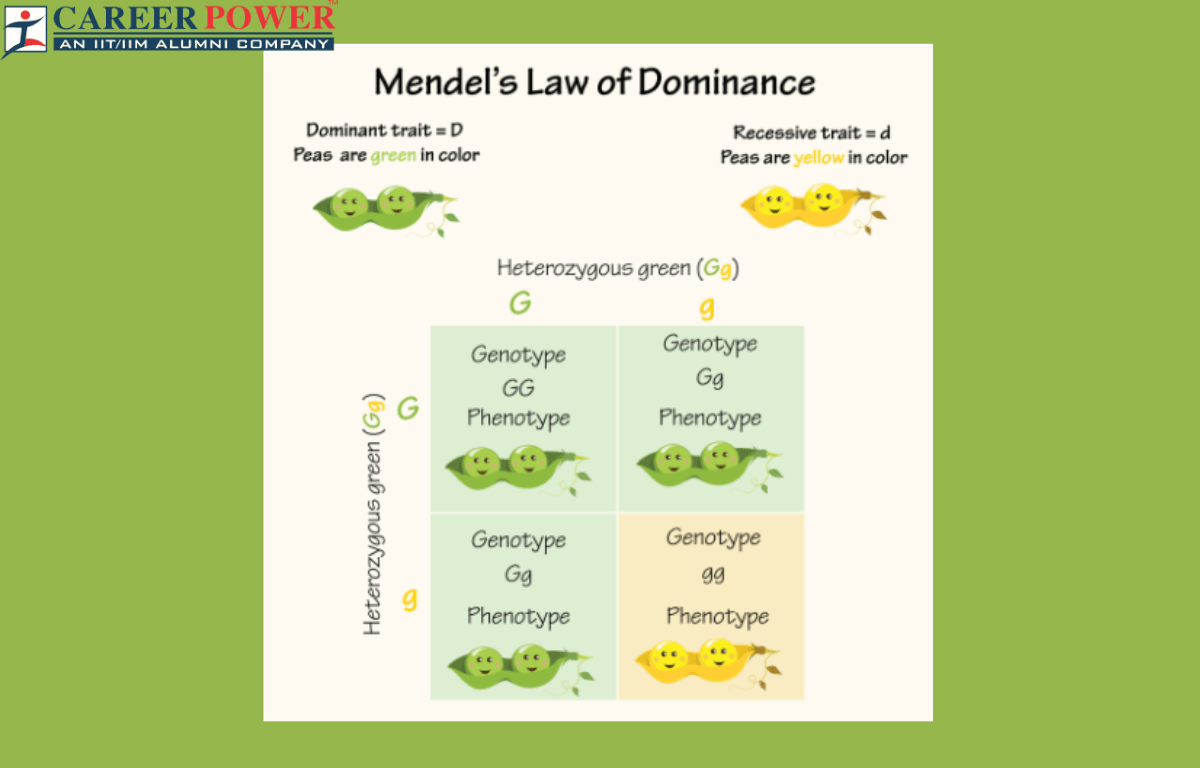Gregor Mendel, an Austrian scientist, discovered the basic principles of inheritance. Mendel’s laws of inheritance are named the law of segregation, the Law of Independent Assortment, and the law of dominance. He found that traits, like eye color, are determined by “genes” passed from parents to offspring. Mendel’s laws state that genes come in pairs and segregate randomly during reproduction. Some traits can dominate others. His work laid the foundation for modern genetics, explaining how traits are inherited through generations. Here we have briefly described the law of dominance below in the article.
Law of Dominance
The law of dominance was proposed by Gregor Mendel. This law states that in a heterozygous pair of alleles (one dominant allele and one recessive), the dominant allele will be expressed in the phenotype, making the effect of the recessive allele. Only when an individual carries two recessive alleles (recessive homozygous) will the recessive trait be expressed. This principle explains the inheritance of traits in organisms and is a fundamental concept in genetics.
What is the Law of Dominance?
The Law of Dominance is a key concept in genetics, but it’s important to note that Mendel’s experiments primarily focused on traits controlled by a single gene. In cases where multiple genes influence a trait (polygenic traits) or when gen interactions are more complex (incomplete dominance), the simple dominance/recessive model doesn’t fully apply. As our understanding of genetics has advanced, researchers have uncovered various exceptions and nuances to Mendel’s laws, leading to a more comprehensive understanding of how traits are inherited and expressed in organisms.
Examples of the Law of Dominance
The law of dominance, proposed by Gregor Mendel, states that in a pair of contrasting traits, one trait will be dominant over the other, which is recessive. Here we have discussed a few examples of the law of dominance. These examples illustrate the principle of dominance, where one allele (the dominant one) masks the expression of the allele (the recessive one) in heterozygous individuals.
- Eye Color in Humans: Brown eye color is dominant over blue eye color. If a person inherits one allele for brown eyes and one for blue eyes, they will have brown eyes due to the dominant nature of the brown allele.
- Hair Type: In humans, curly hair is dominant over straight hair. If one parent has curly hair (even if they carry a recessive straight hair allele) and the other parent has straight hair, their child is likely to have curly hair.
- Pea Plants (Mendel’s Experiment: Mendel crossed pea plants with yellow peas (dominant trait) and green peas (recessive trait). The first generation (F1) always has yellow peas, showing the dominance of the yellow trait over the green.
- Tongue Rolling: The ability to roll the tongue is a dominant trait. If at least one parent can roll their tongue (has the dominant allele), their child will also be able to roll their tongue, even if the other parent cannot.
- Seed Shape in Peas: Mendel also studied seed shape. He found that round seeds are dominant over wrinkled seeds. When he crossed plants with round seeds and plants with wrinkled seeds, the F1 generation had all round seeds, demonstrating the dominance of the round seed trait.
Experiment of the Law of Dominance
The law of dominance is a principle in genetics that states that one allele in a gene pair can mask the expression of the other allele. This means that only the dominant allele is observed in the phenotype, while the recessive allele remains hidden. One classic experiment illustrating this concept is Mendel’s pea plant experiments.
In one of Mendel’s experiments, he crossed purebred tall pea plants (with two dominant alleles for height, TT) with purebred short pea plants (with two recessive alleles for height, tt). The first generation of offspring (F1 generation) all turned out to be tall. This observation supported the law of dominance because the dominant allele for tallness (T) masked the expression of the recessive allele for shortness (t) in the phenotype.
Steps involved in the Experiment of the Law of Dominance
Here are the steps of Mendel’s pea plant experiment demonstrating the law of dominance. These results led Mendel to formulate the law of dominance, explaining that the dominant allele (T) masked the expression of the recessive allele (t) in the F1 generation. This experiment laid the foundation for modern genetics and our understanding of heredity.
Step 1: Selection of Purebred Parents
Mendel selected pea plants that were purebred for specific traits, such as tall plants (TT) and short plants (tt). Purebred plants have the same alleles for a particular trait.
Step 2: Cross-Pollination
Mendel cross-pollinated the purebred tall plants (TT) with purebred short plants (tt). He ensured the transfer of pollen from the stamen of one plant to the pistil of another to facilitate crossbreeding.
Step 3: F1 Generation
The resulting offspring, known as the first filial generation (F1) generation), were all tall (Tt). This was a surprising observation because according to the prevailing belief at that time, a blend of parental traits was expected.
Step 4: Self-Pollination of F1 Generation
Mendel allowed the F1 generation plants (Tt) to self-pollinate. This means that the plants were allowed to pollinate themselves, or he manually transferred pollen from the flower’s stamen to its own pistil.
Step 5: F2 Generation
The F2 generation, the offspring of the self-pollinated F1 plants, showed a 3:1 ratio of tall to short plants. Approximately 75% of the plants were tall (TT or Tt) and 25% were short (tt).



 50 Vegetables Name for Kids in English a...
50 Vegetables Name for Kids in English a...
 Food Chain: Definition, Types, Examples,...
Food Chain: Definition, Types, Examples,...
 Human Respiratory System: Definition, Di...
Human Respiratory System: Definition, Di...













